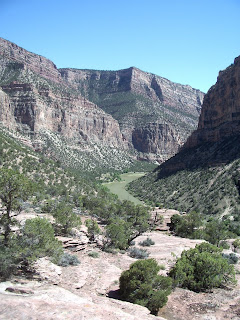As in most states, public K12 teachers must collect some college credits every so often in order to keep their license current. A crazy notion in Colorado is that I can't get credit for the classes I teach, so I signed up for a few classes to reup my license for the next few years. Not surprisingly, I decided to take a geology class that uses river craft to explore an area.
This class used rafts and canoes to float the Green River from the Flaming Gorge Dam through the Gates of Ladore into Dinosaur NM. It was fun exploring a site close to where I do most of my work. Many rock units were the same as on the Colorado Plateau while others were new to me. What fun! Geology aside, it was interesting to watch an instructor and see how she taught. The canoeing and rafting wasn't hard to take either. I know have my requisite credits and soon should have my license approved for the next five years.
The geologic time walk. The instructor took us on a little hike with each step as one million years, giving a whole new meaning to "that was one small step for a man". It is always fun to see how different instructors try and explain the vastness of time.
 The Green River in Ladore Canyon. The Ladore formation is a Cambrian sandstone that lies above the Uinta Mountain Group, a late Proterozoic sandstone/conglomerate. Between the two is a 480 million year unconformity.
The Green River in Ladore Canyon. The Ladore formation is a Cambrian sandstone that lies above the Uinta Mountain Group, a late Proterozoic sandstone/conglomerate. Between the two is a 480 million year unconformity. Ducky-ing into Split Mountain. One of my highlights was to look at the same evidence as John Wesley Powell and see how he came up with his two working hypothesis of an "antecedent canyon" or a "superimposed canyon".
Ducky-ing into Split Mountain. One of my highlights was to look at the same evidence as John Wesley Powell and see how he came up with his two working hypothesis of an "antecedent canyon" or a "superimposed canyon". The antecedent canyon had the river channel established first. Subsequent uplift was slow enough that the river followed its original channel as it cut deeper.
The superimposed canyon had geology first, where bedrock was deformed and then buried under sediment. At a later date, a river eroded through the sediment and eventually cutting into the harder bedrock creating a conundrum for hydrologists.
Powell's notes suggest he leaned towards the antecedent method while more modern reports lean the other way towards a superimposed canyon.
 Deformation at the entrance to Split Mountain. The Split Mountain Anticline. The opposite side of Split Mountain can be seen with one of Ron's gigapan images.
Deformation at the entrance to Split Mountain. The Split Mountain Anticline. The opposite side of Split Mountain can be seen with one of Ron's gigapan images.

 Deformation at the entrance to Split Mountain. The Split Mountain Anticline. The opposite side of Split Mountain can be seen with one of Ron's gigapan images.
Deformation at the entrance to Split Mountain. The Split Mountain Anticline. The opposite side of Split Mountain can be seen with one of Ron's gigapan images.

No comments:
Post a Comment